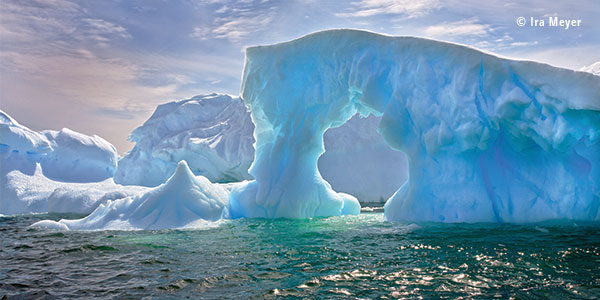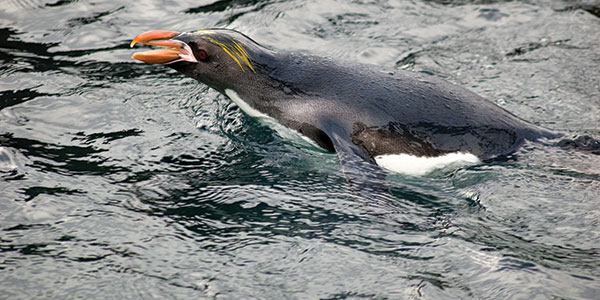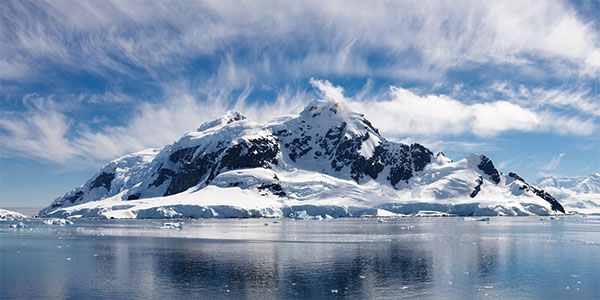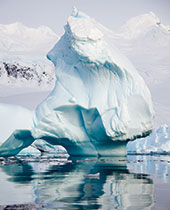Iceberg Vocabulary:
A fantastic variety of shapes result from both the formation and deterioration processes of icebergs. Like snowflakes, no two icebergs are exactly the same. But there are certain basic categories of shapes that are used for Antarctic iceberg observations and different from the Arctic. Surface features and layers of snow from the source glacier may be useful for understanding the recent history of some bergs:
1. TABULAR: large, flat-topped, level, with snow layers and uneroded - like a huge table - if they are derived from ice shelves, or uneven if they are sourced from crevassed floating glaciers;
2. TILTED TABULAR: the most common next stage in the deterioration of tabular bergs due to melting at the waterline, calving of the ice cliff above and tilting (listing) to compensate;
3 TABULAR REMNANT: eroded berg with the last trace of the original snow layers, usually tilted and containing irregular and/or rounded shapes;
4. IRREGULAR: a generally medium or smaller sized eroded berg with little defining shape but more irregular than rounded. May contain pinnacles or spires;
5. DRYDOCK: An iceberg which is eroded in the middle to form a little U-shaped harbor-like enclosure - like a drydock –often with one or more pinnacles;
6. ROUNDED: generally composed of melt rounded and less irregular shapes. On average much older and smaller than other bergs.

What’s the “porpoise” of a penguin?
As we sail Antarctic waters, we’ll see penguins “porpoising,” or leaping out of the water while swimming fast. Why do they do that? Penguins have two ways of swimming. On the surface they paddle relatively slowly using their feet. But when penguins swim fast they are underwater, flapping with their flippers, maintaining a streamlined form with their heads pulled into line with their bodies. That is how they can go fast enough to catch their prey or cover long distances. But they cannot raise their heads above the surface to breathe without breaking their streamlined shape. So how can they breathe without slowing down? They “porpoise”! By leaping into the air every time they need to take a breath, they can continue to swim at full speed, keeping their streamlined shape. Dolphins breathe the same way when swimming fast. Ironically, true porpoises do not “porpoise”! True porpoises are a different family (Phocoenidae) from dolphins (Delphinidae), and the small cetaceans that “porpoise” are really dolphins, a distinction that was lost on whomever coined the verb “to porpoise.”

Beaufort Wind Scale
Wind speed during an Antarctic Expedition cruise is measured using the Beaufort Scale, a 12 point scale that uses descriptors of the wind strength as indicators of wind speed, sea state, and the size of the waves. Typically descriptors are: “Light Air”, “Gentle Breeze”, and “Fresh Breeze”. The terms below are the ones you’re most likely to encounter.
Descriptive Term Effects Observed at Sea:
- Light air Ripples with the appearance of scales are formed, but without foam crests.
- Gentle Breeze Large wavelets. Crests begin to break. Foam of glassy appearance. Perhaps scattered whitecaps.
- Fresh Breeze Moderate waves, taking a more pronounced long form. Many whitecaps are formed. Chance of some spray.

For all the vocabulary and the full Beaufort Wind Scale Table, consult the Environment Canada website.




